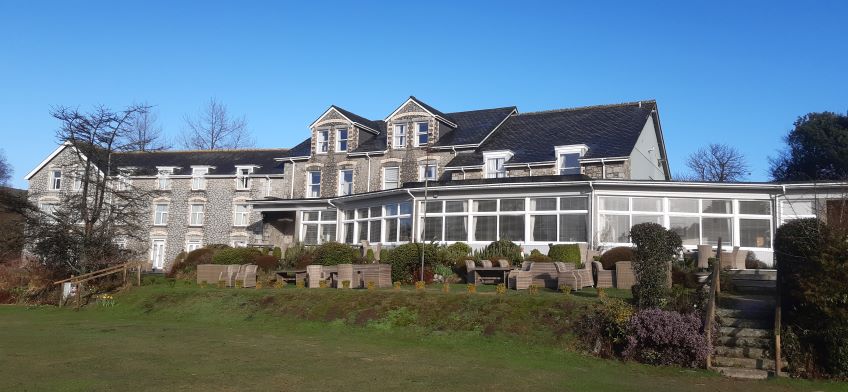Just a few minutes off the busy A30 holiday route to Cornwall and not far beyond Exeter, my wife Jenny and I drove up a winding hill into picturesque Drewsteignton. Here we stopped outside the 17th century Drewe Arms in the tiny village square for a coffee break and to use the facilities.
But sadly the inn had closed six moths earlier, so we were told by locals Shelley Mansfield, Glyn Martin and Ian Marten, who were manning a small village produce stall, just a few steps away inside the entrance to the parish church.
Luckily there were public loos just around the corner and the three, who are hoping their inn will be acquired and taken over by a village collective, sold us a veg pasty to have with our picnic lunch.

This was the first morning of our three-day early spring minibreak based at The Moorlands Hotel close to jagged Hay Tor.
Now we drove down a narrow and winding lane into a deep valley to one of the Dartmoor National Park’s most famous beauty spots, namely the Fingles packhorse bridge over the River Teign.
Here, cars can park beside the road, under a canopy of trees, and while most stroll down to the bridge, others choose the sharply rising footpath opposite.
Quite a long and steady climb is now rewarded with a magnificent walk high above the river, affording stunning views over the deep wooded valley and the surrounding countryside.
This Hunters Path leads walkers along the hillside past the towering ramparts of the National Trust’s Castle Drogo, which we planned to visit another day, and down to a road where walkers turn left to descend to the river and so back to Fingles Bridge for, by then, most welcome refreshments at The Fingle Inn.
This walk takes around three unhurried hours, allowing for a picnic, but the riverside path is uneven in places and there is a short, but quite steep section where use of a hand rail is essential.
Driving back up the lane, amid high banks, we were forced to make an emergency stop as a small herd of agile and highly nervous deer suddenly appeared and began crossing hesitantly, one at a time, in front of us.
Excitement over, we followed the lanes past the castle entrance and down to the Moretonhampstead road for a twenty-minute drive on to Bovey Tracey and thence up to the hamlet of Haytor and The Moorland Hotel.
This Coaching Inn Group property, set in extensive grounds right on the edge of the moor, ablaze with bright yellow gorse bushes at this time of the year, is only a short stroll from the famous Hay Tor and makes an ideal base for exploring the national park.

For example, it is close to Widdecombe in the Moor, whose church of St Pancras is known as The Cathedral of the Moors because of the height of its tower, and just over seven miles from spectacular Dartmeet, where the East and West Dart rivers join.
But the following morning we decided to drive back along the way we had come to visit the small village of Lustleigh, which is only three miles out of Bovey Tracey, and is, in my opinion, the most illustrious of all Dartmoor’s hidden gems.
It’s easy to miss the small signpost which leads into this pretty village with its 15th century Church of St John the Baptist, Cleave Inn, tea shop with gardens and small streamside park where the names of successive May Queens are painted on a smooth granite outcrop.
But best of all from our walker’s perspective, is that the deep and wooded Lustleigh Cleave, an area of temperate rainforest, is close by.
A climb up a narrow lane out of the village is then rewarded by another steeply descending path down to an iconic stone packhorse bridge over the River Bovey, which can only be accessed on foot, and here, Mother Nature is truly in charge.
The walk up river amid the trees with the sound of the water, thunderous after heavy rain, as it was on this memorable morning, is truly magnificent, especially if one is in search of a little reflective solitude.
A two to three hour round trip walk up-river to a second bridge and then up hill and down dale, returning through the village park, requires a little map reading or intuitive nose following, but is well worth it if one stops for a picnic along the way.
Lustleigh has had a small garage at the entrance to the park for as long as I can remember, but this time we decided on impulse to call in and chat to owner Brent Oliver.
His father Roy ran the business for eighteen years until he took over thirty-five years ago, but there had been a garage there since 1927, we were surprised to learn.
Of course we could not leave Lustleigh without calling in at The Cleave Inn and storm clouds were gathering as we drove back to the hotel for some welcome chill-out time.
On our final day we visited Castle Drogo, whose impressive granite ramparts we had viewed on our first walk.
This masterpiece of early twentieth century architecture and the last castle to be built in England between 1911 and 1930, was designed by Sir Edwin Lutyens for self-made millionaire, Julius Drewe, founder of the huge Home and Colonial Stores chain.
The family gave the castle to the National Trust back in 1973 and circa £15 million has been spent on making the previously leaking flat roof structure weather proof over the past eight years. The investment has included an impressive new visitors’ centre, café and shop a five- minute walk from the castle and close to its magnificent gardens.
Entering the beautifully furnished 106 room castle, with all its interior designs also by Lutyens, is like stepping back in time to when Julius and his family were in residence and is truly fascinating experience.




